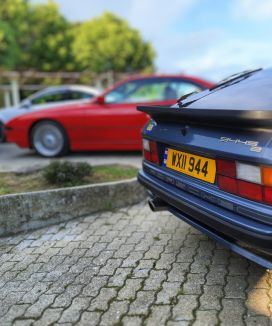Choosing Which BMW M5 To Invest In: A Model-by-Model Analysis
Table of Contents
In the realm of classic cars, the BMW M5 stands as a beacon of engineering excellence and timeless allure.
For those enchanted by the romance of classic cars, the M5 is a ticket to an exclusive club of discerning collectors and enthusiasts.
This guide is your compass in the vibrant world of BMW M5 investments. It’s a journey through the evolution of power, style, and technological prowess, offering insights into making a smart investment that brings both financial rewards and the indescribable joy of ownership.
Whether you’re a seasoned collector or a newcomer dreaming of your first classic car, the path to selecting the right BMW M5 starts here, blending the thrill of the drive with the art of investment.
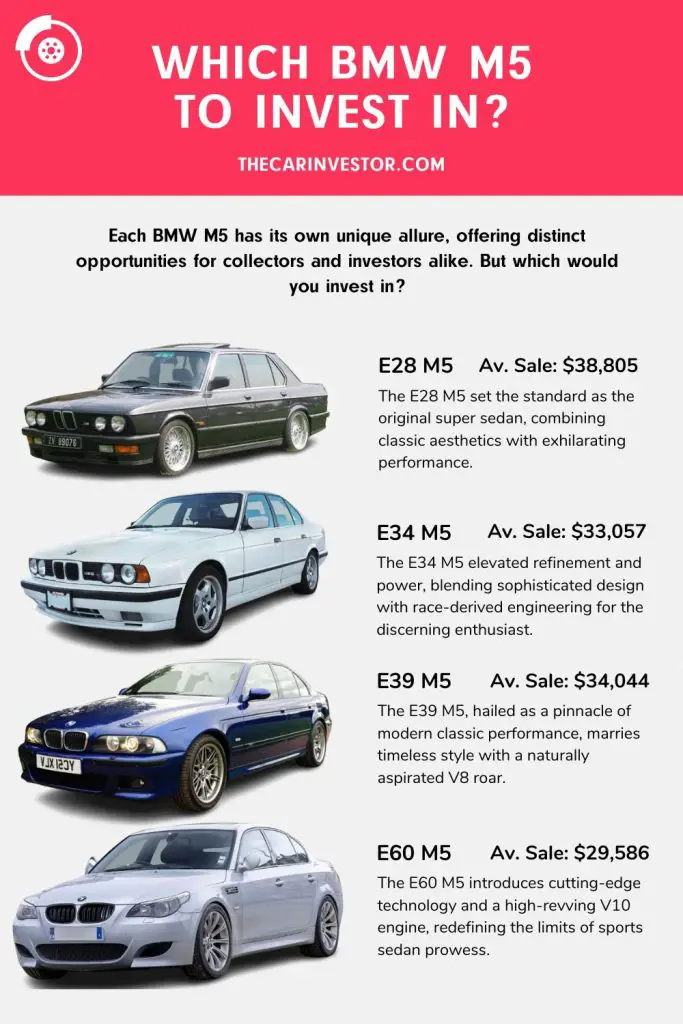
The Allure of Investing in BMW M5s
At the heart of the M5’s allure is an unmatched blend of factors that collectively argue for its investment potential.
Firstly, performance is paramount. Each M5 model, from its inception with the E28, has been a technological marvel, setting benchmarks for speed, handling, and engineering that have stood the test of time.
This performance pedigree makes it not just a car to be seen in, but one to be experienced, ensuring its desirability remains high.
Rarity plays a crucial role as well. With each iteration, BMW produced the M5 in limited quantities, making ownership an exclusive privilege.
Certain models, especially those with unique configurations or limited production runs, are particularly sought after, driving up their value as scarcity fuels demand.
The historical significance of the M5 cannot be overstated. As the original super sedan, it carved out a new niche in the automotive market, combining family car practicality with sports car performance.
This legacy contributes to its investment appeal, as collectors and enthusiasts seek to own a piece of automotive history.
Lastly, the emotional connection that drivers and collectors have with the M5 series adds an intangible value.
E28 M5: The Original Powerhouse
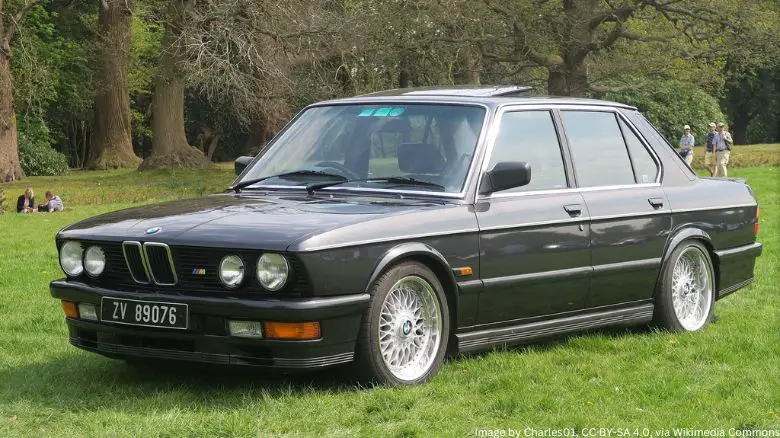
The E28 M5, introduced in 1984, stands as the progenitor of the M5 lineage, a vehicle that not only set a new benchmark for performance sedans but also captured the imaginations of car enthusiasts around the world.
As the first of its kind, its introduction marked the beginning of a new era in automotive design, where luxury met unbridled power, making it an object of desire and a highly collectible piece for aficionados of classic cars.
With production numbers that are relatively modest, the E28 M5 exudes an aura of exclusivity. BMW produced just over 2,200 units, making each car a rare gem in today’s market.
This scarcity has played a significant role in its investment appeal, as collectors vie for the chance to own a piece of BMW’s illustrious M division history.
Key features of the E28 M5 set it apart from its contemporaries and future successors. It was powered by a 3.5-liter inline-six engine, derived from the legendary M1, delivering 286 horsepower – a remarkable figure for its time.
Its understated aesthetics, combined with the signature M division enhancements, embodied a stealthy approach to high performance, appealing to those who value sophistication as much as speed.
Market trends for the E28 M5 have shown a steady appreciation in value, particularly for well-maintained and low-mileage examples.
Its status as the original M5 has cemented its place as a cornerstone of any serious classic car collection, with its value not just in its performance or rarity, but in the pivotal role it played in automotive history.
The E28 M5 remains a blue-chip investment, embodying the essence of what makes the M division so revered among enthusiasts and collectors alike.
E34 M5: A Blend of Sophistication and Performance
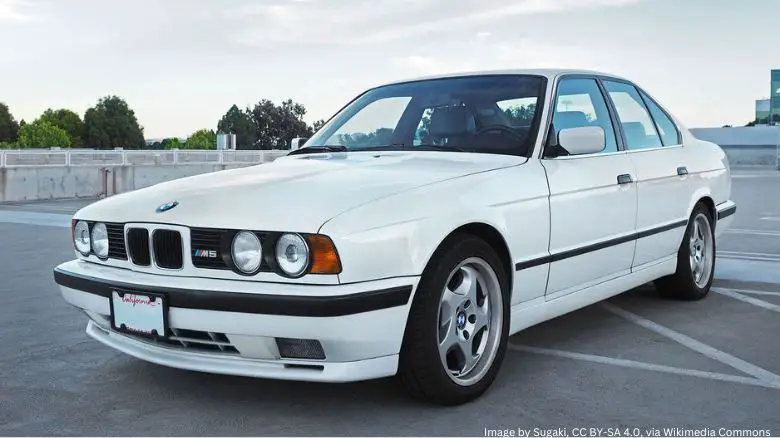
Following the groundbreaking E28, the E34 M5 debuted in 1988, heralding advancements that solidified the M5’s status as the quintessential sports sedan.
The E34 M5 refined the blend of luxury and performance, introducing enhancements that catered to a more discerning clientele without sacrificing the raw excitement of driving an M-badged BMW.
Improvements over the E28 were both mechanical and aesthetic. Under the hood, the E34 M5 featured an evolved version of the inline-six engine, initially offering 311 horsepower and later upgraded in the 3.8-liter variant to produce 340 horsepower.
This increase in power was complemented by sophisticated suspension tuning and a more aerodynamic body, which together offered a more refined yet equally exhilarating driving experience.
The E34’s unique selling points extended beyond its performance. It introduced a level of luxury previously unseen in the M5 series, with a more spacious interior, advanced technology for its time, and improved build quality.
This model was also among the first to offer customization options through the BMW Individual program, allowing owners to tailor their cars to their personal tastes, enhancing both its appeal and uniqueness.
Rarity and special editions of the E34 M5 add to its allure for investors. Production numbers were limited, with just over 12,000 units built, making it less scarce than the E28 but still highly sought after.
Particularly rare are the Touring versions (the wagon variant), of which only 891 were produced, and the limited-run ‘Nürburgring Edition’ models, which featured enhanced handling and exclusive interior fittings.
For investors, the E34 M5’s potential investment value lies in its unique position as a bridge between the raw, pioneering spirit of the E28 and the more technologically advanced models that followed.
Well-preserved examples, especially those with low mileage, rare configurations, or special edition provenance, are increasingly commanding premium prices in the classic car market.
As appreciation for the sophistication and performance of the E34 M5 grows, it represents a compelling blend of driving pleasure and investment potential, making it a standout choice for enthusiasts looking to add a classic yet accessible piece of BMW’s M legacy to their collection.
E39 M5: The Modern Classic
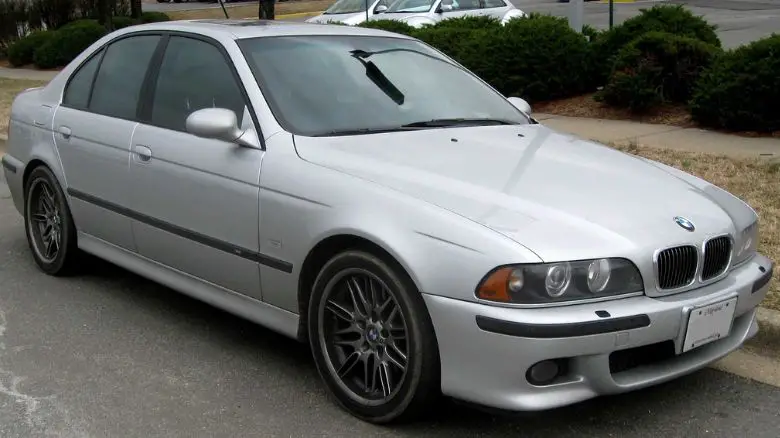
The E39 M5, launched in 1998, is often revered by enthusiasts and critics alike as the best M5 ever made, a testament to its enduring appeal and iconic status.
This model encapsulates a golden era of BMW design and engineering, striking a near-perfect balance between performance, comfort, and everyday usability, without the aid of the complex electronics that characterize later models.
The reason for its esteemed reputation lies in its masterful combination of a naturally aspirated 4.9-liter V8 engine – the first V8 in M5 history – producing 400 horsepower, with a sophisticated yet understated design.
This powertrain offered explosive performance while maintaining a level of refinement and reliability that made the E39 M5 as suitable for daily driving as it was exhilarating on the track.
Its manual transmission, a rarity in today’s market, further endears it to purists who crave an engaging, hands-on driving experience.
The E39 M5’s balance of usability and collectibility is a key factor in its investment allure. It is a vehicle that can be enjoyed on a daily basis, with enough comfort and practicality to serve as the only car one might need, yet it possesses the pedigree, performance, and rarity to make it highly collectible.
Its design, characterized by classic lines and a timeless silhouette, has aged gracefully, contributing to its desirability among collectors and enthusiasts who appreciate its aesthetic appeal as much as its performance capabilities.
Factors affecting its value include condition, mileage, provenance, and originality. Low-mileage examples that have been well-maintained and remain close to their factory specifications are particularly valuable.
The E39 M5 stands as a modern classic, embodying the essence of what many believe the M5 should be: a powerful, elegant, and versatile sedan that excels in every aspect, from performance to practicality.
Its status as perhaps the most beloved M5 model ensures its place in the pantheon of great investment-grade classic cars, offering a unique combination of joy, prestige, and potential financial return to those lucky enough to own one.
E60 M5: Technological Marvel
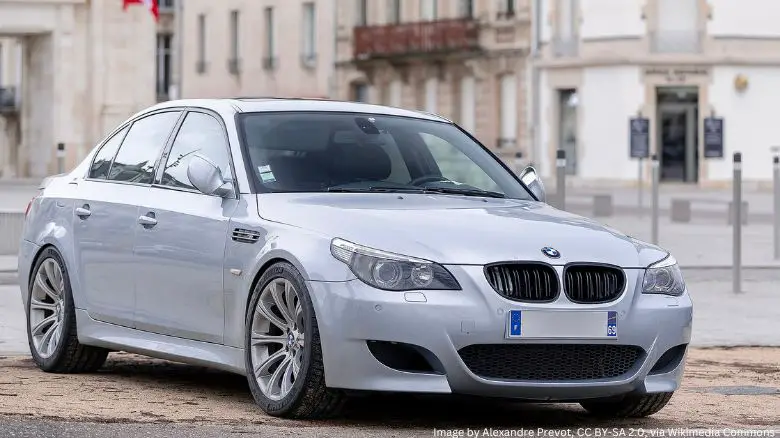
The E60 M5, introduced in 2005, marked a significant departure from its predecessors by embracing a technological revolution that positioned it as a marvel of its era.
At the heart of this transformation was its groundbreaking 5.0-liter V10 engine, a first for the M5 series and a direct descendant of BMW’s Formula 1 racing heritage.
This power unit delivered an astonishing 507 horsepower, enabling the E60 M5 to achieve performance figures that were previously unthinkable for a luxury sedan, including a 0 to 60 mph sprint in just 4.7 seconds.
Beyond its raw power, the E60 M5 introduced a suite of technological advancements that enhanced its driving dynamics. The inclusion of the SMG (Sequential M Gearbox) provided drivers with rapid gear changes through paddle shifters, a novelty that brought the thrill of racing technology to the public road.
Its advanced Electronic Damper Control (EDC) and a high level of customization for driving modes allowed owners to tailor the driving experience to their preferences, from comfortable cruising to track-focused aggression.
In today’s market, the E60 M5 occupies a unique niche that combines its status as a technological showcase with a growing appreciation among collectors and enthusiasts.
Its V10 engine, a rarity in today’s turbocharged and downsized world, is increasingly celebrated for its distinctive sound and high-revving nature, qualities that are becoming more valued as they disappear from modern vehicles.
The future investment potential of the E60 M5 is promising, driven by its uniqueness as the only V10-powered M5 and its technological achievements.
As younger enthusiasts enter the classic car market, the E60’s appeal is likely to increase, particularly for well-maintained, low-mileage examples.
Special editions, such as the M5 Touring (wagon) version, which was not offered in all markets, and models with the rarer 6-speed manual transmission available in the North American market, are especially desirable.
While the E60 M5 may present more maintenance challenges than its simpler predecessors due to its complex technology, its significance in BMW’s history and its raw emotional appeal are undeniable.
As appreciation for this era of automotive engineering grows, the E60 M5 stands as a compelling investment for those drawn to its blend of extreme performance, advanced technology, and the unique status of its V10 engine in the pantheon of BMW’s M division.
Predictions for the Future
While specific market trends can be unpredictable, educated speculation, grounded in current dynamics and historical patterns, allows for some intriguing forecasts regarding which M5 models might see the most significant increase in value.
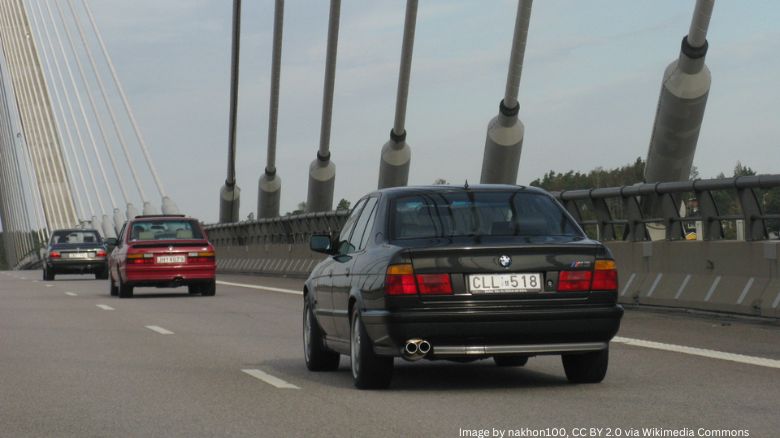
The E28 M5, as the original M5, holds a special place in automotive history. Its pioneering status, coupled with limited production numbers, suggests that its value will continue to climb.
Collectors and purists place a premium on originality and provenance, qualities that the E28 possesses in spades. As the market for classic cars grows more sophisticated, the allure of owning the first of its kind – a model that introduced the super sedan concept to the world – will likely drive further interest and investment.
The E39 M5 is widely predicted to see a significant appreciation in the near future (and has already seen a jump in recent years).
Many experts and enthusiasts consider it the zenith of the M5 series, blending performance, aesthetics, and analog driving pleasure in a package that is becoming increasingly rare in the age of digitalization.
Its V8 engine, manual transmission, and balanced chassis make it highly desirable for those looking to experience the pure essence of driving.
The E60 M5, with its unique V10 engine and technological innovations, represents a potential sleeper hit in terms of future value.
As the last naturally aspirated M5 and the only one to feature a V10, its distinctiveness in the lineage is unmatched.
As trends shift towards valuing uniqueness and technological milestones, the E60 could become a sought-after model for collectors looking for a blend of modern performance and historical significance.
While the entire M5 series holds a revered place in the automotive investment landscape, the E28, E39, and E60 models stand out as particularly promising in terms of future appreciation.
Their unique blend of performance, innovation, and historical significance positions them as smart investments for those looking to combine financial potential with the joy of owning a piece of automotive history.
Which Did I Choose?
After delving deep into the history, performance, and unique characteristics of each M5 model, my decision came down to not just the numbers on a spreadsheet but a call to what resonated most deeply with my passion for cars and investment instincts.
The choice? The technological titan of the series, the E60 M5. Here’s mine:
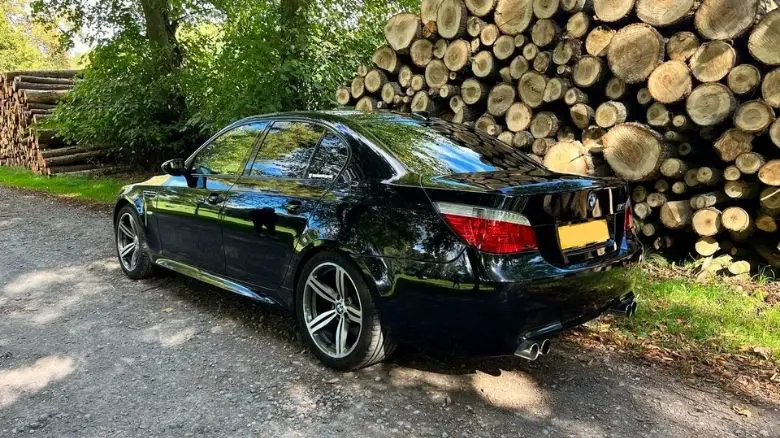
Although the E39 was a close second for me, the E60 M5 represents a pinnacle of engineering ambition for BMW, a bold leap into the future with its high-revving V10 engine – a marvel that ties the visceral excitement of Formula 1 to the practicality of a luxury sedan.
Choosing the E60 was influenced by several factors beyond its groundbreaking technology. Its rarity and the unique position it holds in the lineage of M5s – a bridge between the analog purity of earlier models and the digital sophistication of later ones – underscore its potential as a future classic.
The exhilarating driving experience it offers, characterized by the symphonic roar of its V10 and the precision of its handling, makes every journey an event.
With the automotive world rapidly shifting towards electrification, the E60 M5’s naturally aspirated V10 engine represents a dying breed, a piece of engineering art that is unlikely to be replicated.
This rarity, combined with the car’s significance in BMW’s history, suggests a promising appreciation trajectory as more enthusiasts seek to own a piece of this disappearing era.
ABOUT THE AUTHOR
Adam Chinn writes about the intersecting worlds of classic cars, driving pleasure, and smart investment strategies. Starting his journey at 26, he’s proven that one doesn’t need to be wealthy to begin investing in classic cars.
Adam’s insights have been recognized on platforms such as MoneyInc, Swagger Magazine, and Top Speed.

